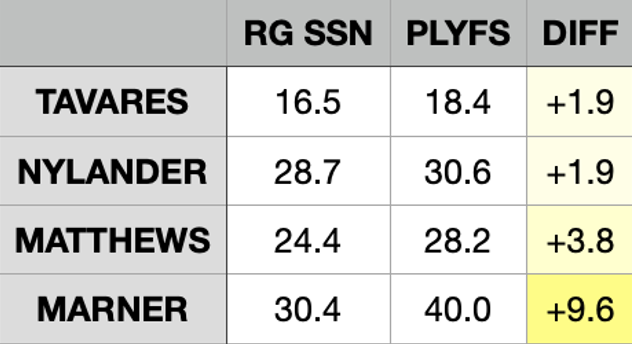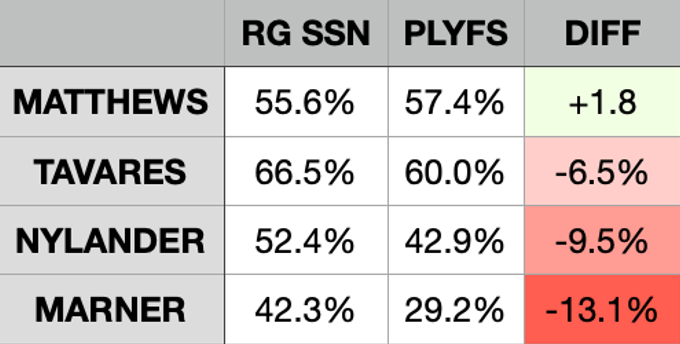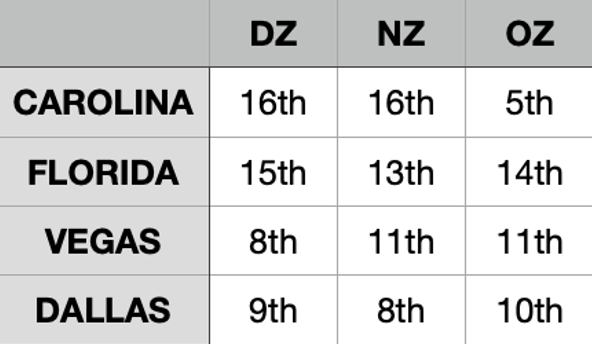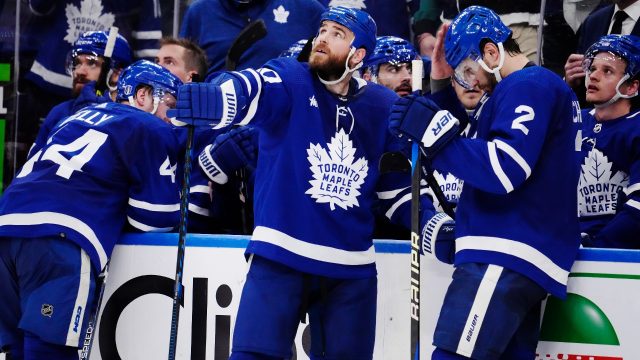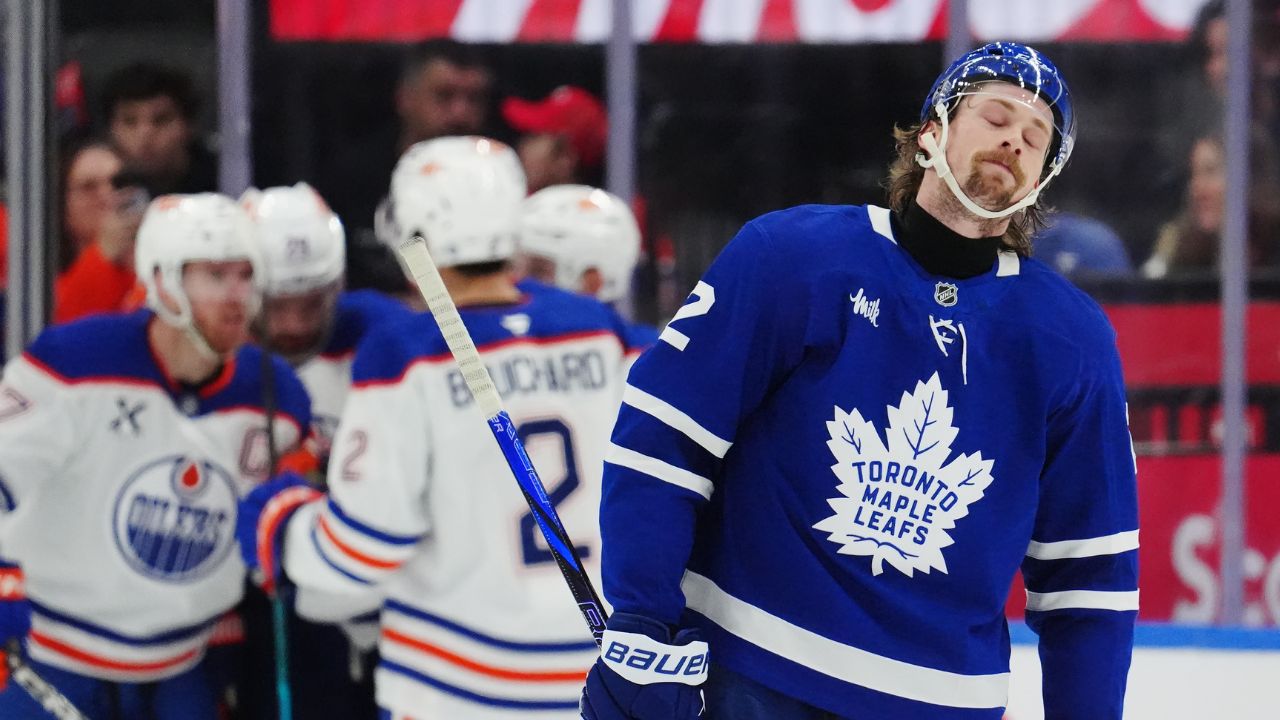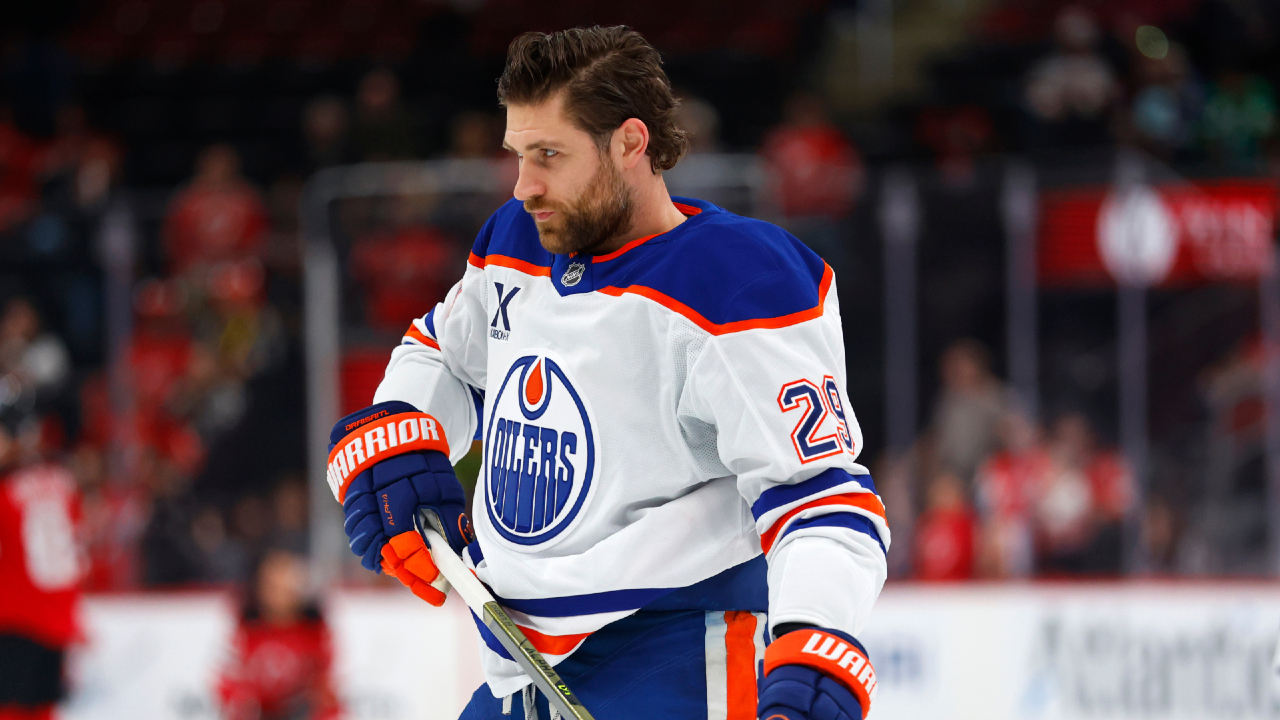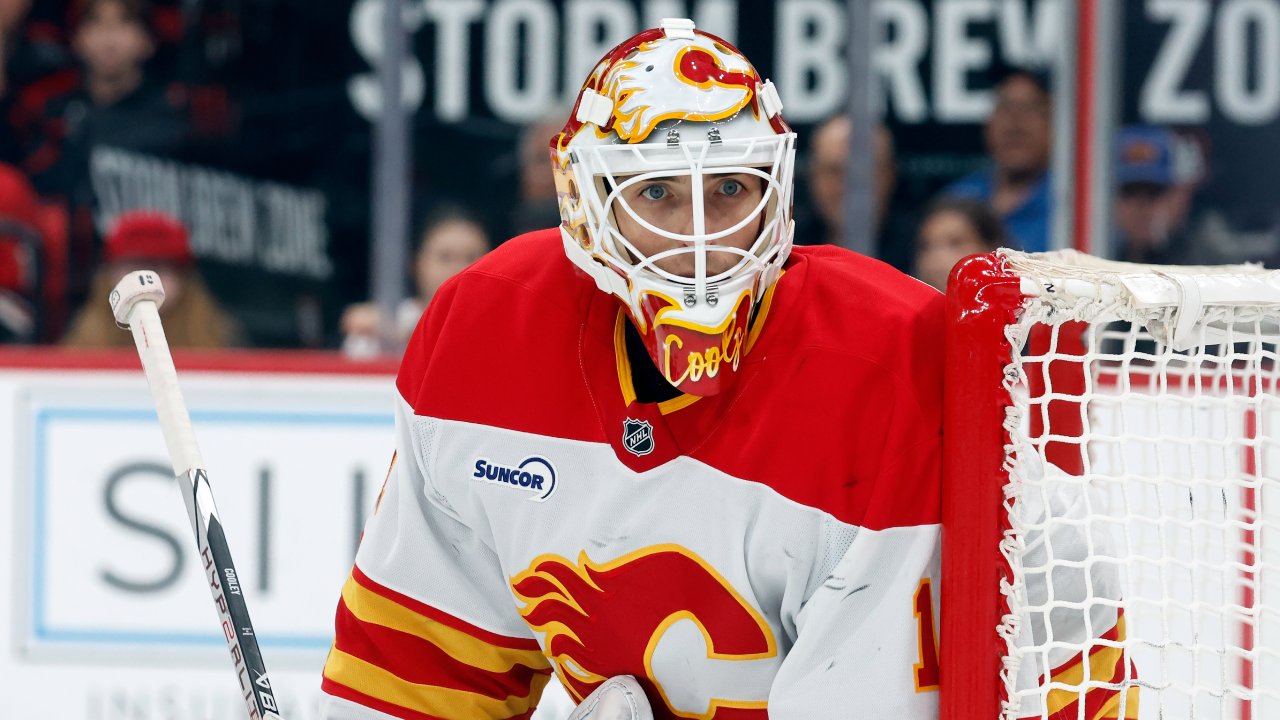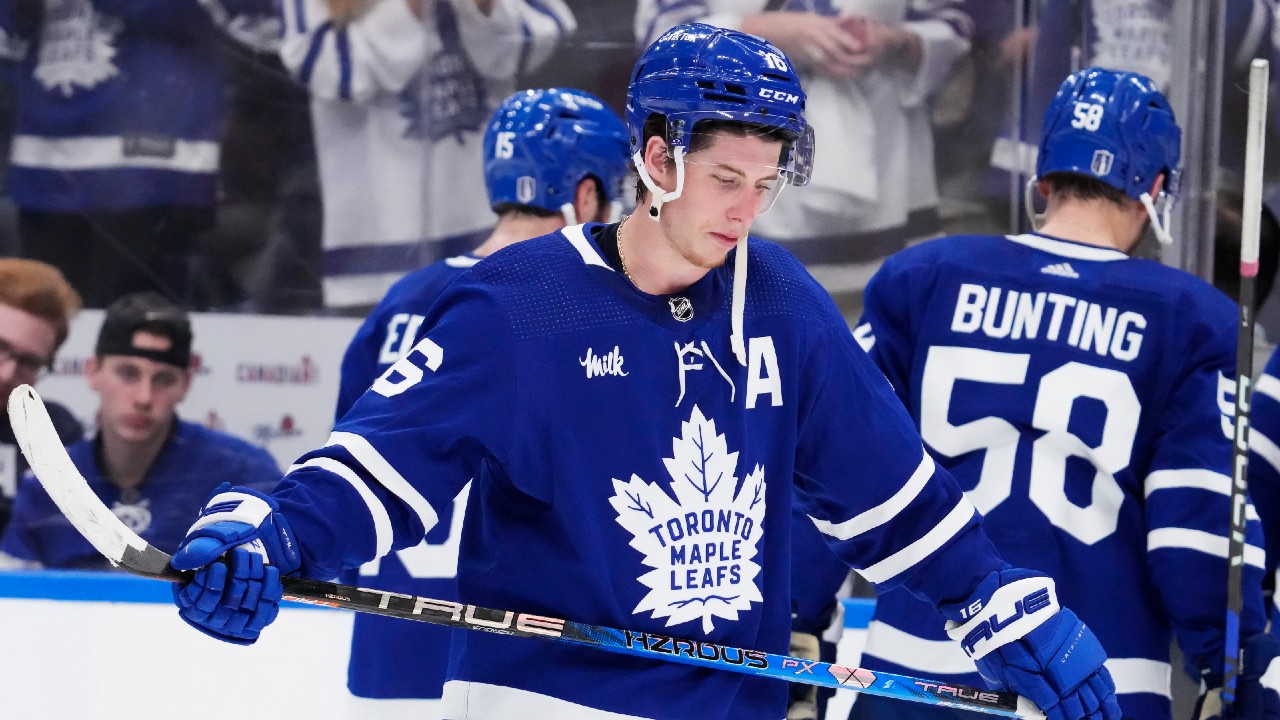
There have been plenty of discussions already about where this Toronto Maple Leafs team has been, a period of time which has now been blanketed as “falling short of expectations” (in kind terms) without much further review. Eyeballs are now trained forward.
“These guys can’t get it done” and “the core didn’t score” and now it’s on to what major surgery should be done. Remove an arm for more legs, maybe? I dunno, let’s just get to cuttin’.
The problem is it’s impossible to prescribe an effective treatment without first coming to an accurate diagnosis.
How and why did the Leafs fall short again this year? We know that their core failed to score enough, but why is that, and what needs to be added or subtracted? What did we see and what do the numbers say?
I’ve got plenty of thoughts, and so with a few days to think about it, here’s the stuff worth discussing.
Getting to the net to score
As long as I’ve been writing about the Leafs falling short in the playoffs over the Matthews/Marner years, the theme for why their scoring dries up has been the same. They can’t get to the inside, they get stuck outside on the perimeter, and suddenly they get “goalie’d.” I wrote an article March 17 titled, no joke, “To create offence in playoffs, Maple Leafs must prioritize getting to the inside.” It includes an example of what Nylander was showing that I liked and that could work in the playoffs. Maybe you saw something familiar to this in Game 5, where he didn’t settle for skating it behind the net?
Getting to the net as a priority is not unique to the Leafs in the playoffs, but still one they fail to solve with consistency.
It’s no coincidence the opposing goalie against the Leafs suddenly turns into prime Dominik Hasek. Below is the average shooting distance of Toronto’s core four forwards in the regular season and playoffs. I’ll note you’re down to just the good teams in the post-season, so it gets harder to have the same average. And the physicality and intensity gets higher, so again, it gets harder to maintain your distance.
But still, everyone is shooting from farther way (measured in average feet from the net per shot).
Imagine tacking two, or four feet, on to every shot you take in the regular season and expecting the same results. Let alone nearly 10.
Another way to look at this is by “portion of shots from the slot.” This is just compared to themselves — are they getting the same quality looks they usually get per shot? The answer, outside of Matthews, is a pretty clear “no.”
Marner’s “portion of shots from the slot” percentage was last on the Leafs in the playoffs by over 10 per cent. Michael Bunting, another important forward for them, saw his percentage drop from 63.5 per cent (second best in regular season) to 57.1 per cent.
The Leafs did have some players whose portion of shots from the slot went up in playoffs, and it’s who you’d expect – Ryan O’Reilly, Noel Acciari, and Sam Lafferty to name a few.
Two crazy stats that are somewhat related: One, is that Matthew Knies had five regular season shots, 100 per cent of which were slot shots. He had six shots in the playoffs, and 90.9 per cent of them (so, five) were slot shots. Make no mistake, they missed him later in the series.
And second, in terms of successful (as in, they landed on net) shots taken from the inner slot in the playoffs, John Tavares had twice as many as the next best Leafs player with 20 in just 11 games. That he only had four playoff goals is crazy; he’s the only guy who can really make a claim to have gotten “unlucky” with his post-season output (his secondary assists also dried up, which is partially bad luck).
Making sense of Matthews
The Tavares inner slot shots thing is interesting to me, because it says he was better than the next best Leafs player by double, but that wasn’t even Matthews, it was Nylander. Matthews may have had a higher slot shot percentage in the playoffs than the regular season, but he only tallied eight inner slot shots in 11 games after averaging 1.3 per game in the regular season. His usually lethal shot didn’t have quite the same sting, and part of that may have been because his chance quality just dropped enough to bail out the opposing goaltenders.
It’s also tough to make sense of Matthews’ dried-up point totals, but what really dropped were his primary assists, which went from 1.16 (per 60) to 0.48. Hindsight is 20/20, but seeing how far Marner was living from the net in the above stats, and that Calle Jarnkrok was on Matthews’ left side, maybe it would’ve been tough to tally many points on passes.
Matthews looked off at times this season compared to the previous year’s standard. And it wasn’t just his inner slot shot pace, or primary assists that dropped in the playoffs, it was his shots per 60 in general. With that, I think it’s a fair criticism of the coach that the team went down with Matthews and Marner tied together to the very end, despite the fact that there was only a primary assist between the two just twice in the playoffs, at all strengths.
Which brings me to…
Passing the puck
My radio co-host Nick Kypreos has been critical about how the Leafs as a team don’t pass the puck overly well, which sounds crazy, but it’s rooted in a good point. Matthews is a shooter first. Tavares is a shooter first. Nylander is a shooter first. And Marner is a pure passer, so you don’t get much deception from the group.
What’s interesting is where the Leafs rank among this year’s playoff teams in passes (per 60) by zone. They were first out of 16 teams in D-zone passes. They made a lot of little plays to leave their own zone with possession. In the neutral zone they were sixth of 16. But in the O-zone, they were down to eighth.
At first I thought we might be on to something here, but there’s a problem. Let’s talk about playoff hockey.
Passing in the playoffs
You know how I noted the Leafs made lots of nice little passes to exit their D-zone? Yeah I’m not sure that’s the playoff recipe for success with the way teams forecheck today. Here are the rankings of the four remaining teams (out of 16) in “successful passes per 60,” by zone.
They mostly punt it out and punt it in to avoid disaster.
Look at Carolina, where the Rod Brind’Amour plan seems to be “get it the hell out, get it the hell in, move it around once we have it.” It’s a fine plan. Over the three years the Tampa Bay Lightning went to the Cup Final, they were never better than eighth in passing in any zone, in any year. Last year Colorado was 14th in D-zone passes completed and 13th in neutral zone passes completed per 60. (They were third in O-zone passing.)
For the Leafs, Luke Schenn became their second most important D-man in the playoffs. Hmm.
It seems as though these things are all connected, and recognizing that playoffs involve more punting and less cute plays is a reality with the speed of today’s forechecks.
Now, I do believe you can be good enough to pass your way out of trouble with consistency, but it would take a very elite group, which is tough to put together in the salary cap era.
Building work ethic
If you talk about the fundamental flaws of this Leafs era, many will take you back to the contract negotiations of the core guys. And that’s totally fair from a personnel standpoint.
But they’ve also wanted to foster a culture that supported people, made them feel comfortable and recognized as humans, and that’s been a real success of the Dubas-era Leafs. The trust has been transferred to the players to “take what they need” in terms of rest and training, and they give them the benefit of the doubt when they can. These are good things.
The problem some many see is that in the hyper-competitive world of professional sports, overcoming hardships and working through difficulties and showing resilience are integral tools. And too much “support” can put you at the risk of coddling, or enabling in a way, particularly for young players who are being handed the keys to an organization. It certainly avoids the feeling of desperation that comes with losing – and learning to hate it – that many others have to live through.
I was sent this clip today on Joel Embiid of the Philadelphia 76ers, and think what you want about it (it’s too crass in tone for me), it was sent because the person saw relevance to the Leafs.
I don’t love the sort of macho, alpha-male-type push happening in the clip. But I do think there’s underlying value to the point, which in the case of the Leafs has been starting this core with kid gloves and never taking them off.
With the AHL Marlies, the up-and-coming star players didn’t do interviews, and would only play two of every three games during the “three-in-three” schedules that happen in that league (I still don’t know why). Their coach walks back public criticisms, stars rarely have gotten benched (let alone scratched), and it’s looked like you can’t run afoul of anyone from the outside looking in.
I think it’s possible to hold people accountable while providing support as needed, as listed above.
The guys who’ve come in from the outside like Schenn and Ryan O’Reilly – guys who’ve been through the wars and hard coaches and learning lessons – love the Leafs’ culture, which is great and a good sign the team is on the right track. But those players have already built up the callouses and resolve necessary to form that intrinsic motivation, so they deserve the benefit of the doubt. To go back to the top of this point, I wonder: if Toronto could do it all over again with this core, would they be harder on them and dig in more when they fell short of expectations? It would’ve helped in contract negotiations, sure, but wouldn’t have hurt with the overall culture either.
And finally,
The core direction
If you want my full thoughts on Matthews, I recommend listening to the second half of our radio show Monday, in which I explain why you have to re-sign him and why I believe you can win with him at the heart of your team. I don’t think he’s going to want much term though (the way NBA players prioritize their ability to get new, big deals and change teams at will), and I think if that’s the compromise you have to make, you make it (within reason). By going short on Matthews’ last contract, the Leafs got a rare lucky break – he won’t be due a massive raise on his next contract (yay pandemic?). Maybe a couple million bucks AAV, but nothing crippling.
I can see a world where the Leafs view Nylander walking after this season as adding his cap space, the way Vegas traded Max Pacioretty to Carolina for literally nothing. What I’m saying is, if Nylander wants a big number on his next deal, I can still see them keeping him and considering signing him as a UFA like everyone else next summer. Prime Nylander at $6.9 million is awfully appealing to keep, and as much as losing him would hurt, the freed up money would have value in itself.
Tavares is sticking around, and so by process of elimination, I’m curious to see if the calls the Leafs make around the league aren’t on Marner first. He’s an elite talent with a pile of prime years ahead and two years of control left on his contract. Even with some playoff shortcomings he’d have massive value on the open market (he did still get 11 assists in 11 playoff games). With a nice return and a pile of cap space, it’s not impossible to see the Leafs remaining a top team in the Atlantic. And if you’re dug in on change, this looks to me like the most obvious place to start.
The Leafs will be seeking second, third, and fourth opinions on the diagnosis of where things went wrong this past season. But once they reach a consensus, have no doubt the major surgery will begin.



